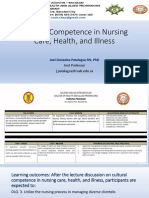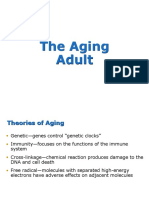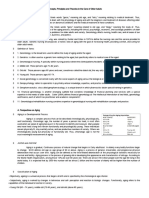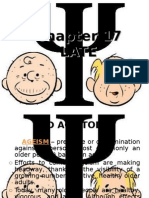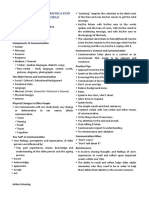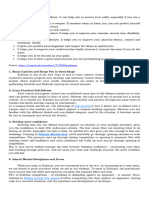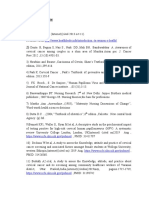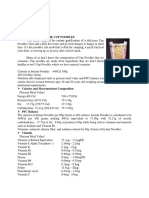Dementia Power Point
Dementia Power Point
Uploaded by
api-253856690Copyright:
Available Formats
Dementia Power Point
Dementia Power Point
Uploaded by
api-253856690Original Title
Copyright
Available Formats
Share this document
Did you find this document useful?
Is this content inappropriate?
Copyright:
Available Formats
Dementia Power Point
Dementia Power Point
Uploaded by
api-253856690Copyright:
Available Formats
Dementia
Presentation by
Brittany Robinson
&
Marli VanLake
What is Dementia
Dementia is an umbrella term for a group of
cognitive disorders that affect:
Memory
Logic and reasoning
ADLs
Abstract thinking
Decision making
Learning
Statistics
Today 35.6 million people suffer from dementia
WHO reports that persons suffering within 18 years
from dementia will double to 65.7 million and triple
by the year 2050
(2007) 3.4 million Americas aged 71 years and
older
14% have dementia
9.7% (2.4 million) have Alzheimer's
1 in 8 American Adults have Alzheimer's
10 Facts on Dementia
1. Dementia is not a normal part of aging
2. 35.6 People live with dementia
3. A new case of dementia is diagnosed every 4
seconds
4. Creates huge economic impact; US $ 604 billion per
year
5. Caregivers experience high strain
6. Early diagnosis improves quality of life for everyone
involved
7. People with dementia and their families are often
discriminated against
8. Awareness and advocacy are needed
9. More research and evaluation is required
10. Dementia is a public health priority
Causes of Dementia
Alzheimer's Disease
Disease of the brain
Most common form of dementia
Progressive stages
Lewy Bodies
Proteins deposits in the nerve cells of the brain
Progressive in nature (affects motor movement)
Vascular Disease
Lack of blood flow to the brain (stroke)
Biological Aspects
Dementia affects the brain in various
ways.
Our brain is made up of many nerve cells that
work together and are specialized in sending
messages to each other.
Individuals with dementia can lose their cells
ability to communicate with each other and will
eventually die.
When communication is lost the brain becomes
unable to function in its usual way and cognitive
impairment appears.
Biological Aspects cont.
Proteins, which are a vital part of our
bodies, are also affected by dementia.
They play apart in the movement of our
muscles and food digestion.
In dementia, there is an excessive buildup
of proteins in the brain which change the
structural component of the brain.
The brain is responsible for a lot of our
body functions and dementia destroys it.
Video
http://www.youtube.com/watch?v=6q-
H1-XwCZA
Psychological Aspects
There are a lot of psychological
changes in a person with dementia
such as:
Changes in mood
Agitation
Anxiety
Depression
Aggression
Delusions
Repetitious behavior
Restlessness
Sociological Aspects
Individuals with dementia experience
different sociological issues
They may feel some embarrassment,
especially if they have lived a very
independent and active life before
They may feel some frustration because
they want to continue to do things for
themselves but they cannot.
Dementia and the family
The family of the person with dementia suffer a
great deal.
the aggressive behaviors, the noncooperation,
anger, and many other factors can affect the
family in various ways. They may feel:
Grief
Loss
Guilt
Isolation
Exhaustion
As the dementia gets worse they are challenged to
come to terms with the fact the person is no longer
themselves anymore.
Video
http://www.youtube.com/watch?v=MD
C1us0nr4c
Implication for TR/RT
Treatment
Treatment approach should be based
on individual cases
Medications, environment, culture,
economic status, and social support
should be considered
Emphasis on quality of life, well-being,
and promotion of independent living
Typical Treatment Goals for
TR/RT
Maintain or Improve Cognitive
Functioning
Maintain or Improve Optimal Physical
Functioning
Improve Behavioral Management
Enhance Social Interaction
Considerations for Cognitive
Treatment Approaches
Limited ability to communicate effectively
Loss of short-term or long-term memory
Decreased Logic, reasoning, and comprehension
What Can TR/RT s Do?
Provide cognitive stimulation for enjoyment
Cognitive training that includes repetition, learning
strategies, all that are tailored to the individual
Considerations for Physical
Treatment Approaches
Evaluate slow gait, hand grip, gross muscle
movements, swallowing, and weight change
What can TR/RT s Do?
TR/RT provide interventions according to the
needs and strengths of patient to enhance quality
of independent lifestyle
Considerations for Behavioral
Treatment Approaches
Can be extremely challenging because patient my
feel; frightened, humiliated, frustrated, eroded
judgment, decreased awareness of surrounding, or
boredom
Also agitation, aggression, and confusion are worth
noting
What can TR/RTs Do?
Make desirable environment
Use specific activities that interest the patient
Use variety of intervention techniques
Considerations for Social
Treatment Approaches
Social Isolation may occur
Loss of belonging
Lead to emotional or mood disorders
What can TR/RTs do?
Build relationships, social support, and a community to
give a sense of belonging
Social interaction may help motivate patients to
demonstrate skills, talents, or memories
Build support system to enable leisure lifestyle and
quality of life
Sample Activity Interventions
Exercise
Chair Zumba,
Wheel chair biking,
Walking
Board Games
Scrabble
Yahtzee
Kings on the Corner
Cooking
Baking cookies
Following a receipt
Sample Activity Interventions
Cont
Reminisce
Trivia
Looking at pictures
Word Scrambles
Pet-Therapy
Playing Catch
Grooming
Petting
Sensory Intervention
Lighting
Music
Sing-A-Longs
Activity
Adaptations/Modifications
Break down activity into simplified
tasks and eliminate tasks that are too
difficult
Modify Environment
Promote Safety and Independence
and Fun
Activity
Adaptation/Modification
Examples of Adaptations:
Games
BINGO; fewer numbers or spaces
Assistive Technology/Adaptive aids
Large grip utensils
Wheelchairs/walkers
Memory Aids
Schedules of daily routines
Environmental
Visual prompts, lighting, structural changes
Video
http://www.youtube.com/watch?v=dOo
9OOL46CU
You might also like
- Dynamic Traits and Expanded Moodles - High Level GuideDocument10 pagesDynamic Traits and Expanded Moodles - High Level GuideDiego Pedro da Silva100% (1)
- Che 251 Care of The Older PersonsDocument22 pagesChe 251 Care of The Older PersonsArum ComradeNo ratings yet
- Quantum HealingDocument2 pagesQuantum HealingCatrin Jacksties70% (20)
- NCM 120 Part 3a Cultural Competence in Nursing Care Health and IllnessDocument44 pagesNCM 120 Part 3a Cultural Competence in Nursing Care Health and IllnessKatrina Dela CruzNo ratings yet
- Conceptual and Philosophical Foundations of Professional Nursing PracticeDocument36 pagesConceptual and Philosophical Foundations of Professional Nursing PracticeDip Ayan MNo ratings yet
- PnclexDocument3 pagesPnclexPaul Michael BaguhinNo ratings yet
- Aging AdultDocument18 pagesAging AdultGladz C CadaguitNo ratings yet
- Cognitive DisordersDocument9 pagesCognitive Disordersgeorgeloto12No ratings yet
- Concepts and Theories of Aging: Princy Francis M I Yr MSC (N) JmconDocument48 pagesConcepts and Theories of Aging: Princy Francis M I Yr MSC (N) Jmconcj bariasNo ratings yet
- Palliative Care: Mrs. Grace Lydia Asst - Professor OacnDocument133 pagesPalliative Care: Mrs. Grace Lydia Asst - Professor OacnSophia Alexa Cassandra AlcantaraNo ratings yet
- Care Giving ManualDocument3 pagesCare Giving ManualRobinPlanNo ratings yet
- Lesson 5 - Planning For Health Promotion and MaintenanceDocument40 pagesLesson 5 - Planning For Health Promotion and MaintenancehaledominiseNo ratings yet
- NCM 116 Alterations in Nutri and GI Rev5Document100 pagesNCM 116 Alterations in Nutri and GI Rev5JxshxzsNo ratings yet
- Gerontology LectureDocument70 pagesGerontology LectureAlessandra MercadoNo ratings yet
- The Role of The Gerontological NurseDocument4 pagesThe Role of The Gerontological Nursesusan100% (1)
- Group 1 Physiological Changes in Aging Affecting Various SystemsDocument22 pagesGroup 1 Physiological Changes in Aging Affecting Various SystemsIra LampayanNo ratings yet
- Clinical Pathway For Family Wellness Promotion in Elderly: Junayyah A. Sarip Jaeron Den D. TopinioDocument36 pagesClinical Pathway For Family Wellness Promotion in Elderly: Junayyah A. Sarip Jaeron Den D. TopinioJunayyah Abdullah SaripNo ratings yet
- Nursing Care of The Older Adult in Chronic Illness JCC Converted 1Document41 pagesNursing Care of The Older Adult in Chronic Illness JCC Converted 1Amelite Meriño0% (1)
- Chronic Illness in Elderly PopulationDocument4 pagesChronic Illness in Elderly PopulationPrincess Agarwal100% (1)
- NCM114 - Learn Mat 1 2021Document32 pagesNCM114 - Learn Mat 1 2021jjNo ratings yet
- Performance Evaluation Tool For Urinary CatheterizationDocument3 pagesPerformance Evaluation Tool For Urinary CatheterizationPrincess Pilove Gawongna100% (1)
- Week 1 PPT Community ConceptsDocument48 pagesWeek 1 PPT Community ConceptsK DNo ratings yet
- Health Care For The Elderly - Day6Document18 pagesHealth Care For The Elderly - Day6Paul JacksonNo ratings yet
- What Is Copar?: COPAR Stands For Community Organizing Participatory Action ResearchDocument4 pagesWhat Is Copar?: COPAR Stands For Community Organizing Participatory Action ResearchRAMIL GOPEZNo ratings yet
- Estimated Average Requirement (Ear)Document9 pagesEstimated Average Requirement (Ear)Rochel Jean Merto AfricanoNo ratings yet
- 1.introduction Psychiatric & SymptomsDocument19 pages1.introduction Psychiatric & SymptomsJunior NahimNo ratings yet
- GERIARTRICSDocument4 pagesGERIARTRICSLoribel Coma100% (2)
- The Health History and Interviewing Process 2Document25 pagesThe Health History and Interviewing Process 2Mitul PeterNo ratings yet
- 1 Basic Concepts of GerontologyDocument26 pages1 Basic Concepts of Gerontologygwyneth guintuNo ratings yet
- Reportinpharma Durante Bsn2aDocument45 pagesReportinpharma Durante Bsn2aSofhysye Sevilla NarvaezNo ratings yet
- Changes in Musculoskeletal System During AgingDocument19 pagesChanges in Musculoskeletal System During Agingsonali tushamerNo ratings yet
- Bhs Pain Management in ElderlyDocument52 pagesBhs Pain Management in ElderlyBagus JuangNo ratings yet
- Aging: The Biology of SenescenceDocument37 pagesAging: The Biology of SenescenceMaddox EdeyajNo ratings yet
- MASTER OF SCIENCE IN NURSING Revised CurriculumDocument5 pagesMASTER OF SCIENCE IN NURSING Revised CurriculumrobbyNo ratings yet
- Chapter 16: Psychological Disorders: Multiple ChoiceDocument4 pagesChapter 16: Psychological Disorders: Multiple ChoiceJamie100% (1)
- Drugs Affecting The Male Reproductive SystemDocument22 pagesDrugs Affecting The Male Reproductive SystemLule Allan PhillipNo ratings yet
- Rehabilitation of The AgedDocument31 pagesRehabilitation of The Agededward osae-oppong100% (1)
- Dev Elopement of The ElderlyDocument7 pagesDev Elopement of The ElderlyRina Ticia QuilingNo ratings yet
- Geriatric SyndromsDocument26 pagesGeriatric SyndromsMOC NAJRAN100% (1)
- Chapter 3: Exercise in Older Adults: Multiple ChoiceDocument2 pagesChapter 3: Exercise in Older Adults: Multiple ChoiceJamieNo ratings yet
- NCM 114 - Finals NotesDocument9 pagesNCM 114 - Finals NotesMaria Emmaculada ConcepcionNo ratings yet
- GerontologyDocument6 pagesGerontologyAlex MarieNo ratings yet
- Aging Process and Its Effect OnDocument42 pagesAging Process and Its Effect OnRufus RajNo ratings yet
- Synopsis 8TH AAAAaaDocument19 pagesSynopsis 8TH AAAAaaعثمان علیNo ratings yet
- Recreation Pertains To Activities Done For Leisure To Promote A Person's Well-Being and Growth. It Brings About A Sense ofDocument2 pagesRecreation Pertains To Activities Done For Leisure To Promote A Person's Well-Being and Growth. It Brings About A Sense ofJee En BeeNo ratings yet
- Responses To AlterationsDocument16 pagesResponses To AlterationsFerlyn BotalonNo ratings yet
- Planning and Intervention in Intrapartum CareDocument5 pagesPlanning and Intervention in Intrapartum CareAngela MariaNo ratings yet
- Course f2f Inp CPRDocument9 pagesCourse f2f Inp CPRMichelle Gliselle Guinto MallareNo ratings yet
- CEU Somatic Symptom and Related DisordersDocument78 pagesCEU Somatic Symptom and Related DisordersErika Louise MiChelle Cua NavasNo ratings yet
- Care of The Older AdultDocument55 pagesCare of The Older AdultJohan Maloloy-onNo ratings yet
- Late Adulthood Physical, Cognitive, and Psychosocial DevelopmentDocument41 pagesLate Adulthood Physical, Cognitive, and Psychosocial DevelopmentJunnel Rose60% (5)
- NCM 114 - ManuscriptDocument10 pagesNCM 114 - ManuscriptJamie Grace AbitNo ratings yet
- DementiaDocument27 pagesDementiaNina OaipNo ratings yet
- The Three D's and Suicide in ElderlyDocument29 pagesThe Three D's and Suicide in ElderlyIqra Razzaq100% (1)
- Lect 4 Anxiety DisordersDocument52 pagesLect 4 Anxiety DisordersAmier IzzatNo ratings yet
- Communication: Module 8 (PPT) : Communication With Older PeopleDocument1 pageCommunication: Module 8 (PPT) : Communication With Older PeopleRyrey Abraham Pacamana100% (1)
- Prepared By: Mylene Karen B. Pueblas, RNDocument136 pagesPrepared By: Mylene Karen B. Pueblas, RNmylene_karen100% (2)
- Chapter 5: Symptoms and Syndromes: Multiple ChoiceDocument5 pagesChapter 5: Symptoms and Syndromes: Multiple ChoiceJamieNo ratings yet
- Marquis Chapter 04 PPT Ethics Issues in Leadership and ManagementDocument25 pagesMarquis Chapter 04 PPT Ethics Issues in Leadership and ManagementSara AssiriNo ratings yet
- DC Your Guide To Diabetes Management PE enDocument9 pagesDC Your Guide To Diabetes Management PE enJimenez Renalyn M.No ratings yet
- Guidelines for Measuring Household and Individual Dietary DiversityFrom EverandGuidelines for Measuring Household and Individual Dietary DiversityNo ratings yet
- Community Health A Complete Guide - 2020 EditionFrom EverandCommunity Health A Complete Guide - 2020 EditionRating: 5 out of 5 stars5/5 (1)
- XXXXXXXXDocument17 pagesXXXXXXXXRicardo LazoNo ratings yet
- Meeting Your My Plate Goals On A BudgetDocument44 pagesMeeting Your My Plate Goals On A BudgetOWNEditorNo ratings yet
- Unit VDocument66 pagesUnit VardanielallenjosephNo ratings yet
- Benefits of ArnisDocument2 pagesBenefits of Arnismagnaxaconstruction1No ratings yet
- Ent Mcqs 4Document7 pagesEnt Mcqs 4Uzair KhanNo ratings yet
- Pathology Ultrasound Ordering by RMRNNPDocument27 pagesPathology Ultrasound Ordering by RMRNNPAbeer MohammedNo ratings yet
- Munyisia Et Al 2011bDocument12 pagesMunyisia Et Al 2011bpita romawatiNo ratings yet
- RBSK Resource MaterialDocument290 pagesRBSK Resource MaterialSachin ParmarNo ratings yet
- Standard - Guidelines For Healthcentre in Nepal PDFDocument58 pagesStandard - Guidelines For Healthcentre in Nepal PDFSANDESH100% (3)
- Prospectus Mbbs KMC 2016.PDF-1206356120Document16 pagesProspectus Mbbs KMC 2016.PDF-1206356120pradeepNo ratings yet
- Indian Standard For Drinking Water As Per BIS Specifications - 2010Document26 pagesIndian Standard For Drinking Water As Per BIS Specifications - 2010Ayush Jain100% (1)
- A Study On Triplet Repeat Expansion Disorders in Western Indian PopulationDocument5 pagesA Study On Triplet Repeat Expansion Disorders in Western Indian PopulationShavana RajkumarNo ratings yet
- EML-Leading-Self-Reflections-WorksheetDocument9 pagesEML-Leading-Self-Reflections-WorksheettonyjesudasNo ratings yet
- Empowerment of Women Through EntrepreneurshipDocument39 pagesEmpowerment of Women Through EntrepreneurshipClassic PrintersNo ratings yet
- Reading Passage 2Document6 pagesReading Passage 2Vinit 46244901No ratings yet
- Knowledge of Cervical Cancer and Acceptance of HPVDocument6 pagesKnowledge of Cervical Cancer and Acceptance of HPVALIF FITRI BIN MOHD JASMINo ratings yet
- REFERENCESDocument4 pagesREFERENCESSanhati Ghosh BanerjeeNo ratings yet
- YogaJournalSingapore February092018Document84 pagesYogaJournalSingapore February092018joaquin.ca.garciaNo ratings yet
- Ijar 30849 - Ijar 30849 PDFDocument6 pagesIjar 30849 - Ijar 30849 PDFMathias PAKANo ratings yet
- Lifeguard TrainingDocument5 pagesLifeguard Traininghenryjacob216No ratings yet
- 3 - Amcat Reading ComprehensionDocument4 pages3 - Amcat Reading ComprehensionSRINIVAS ORAGANTENo ratings yet
- IFH Newsletter - Q1 2023Document4 pagesIFH Newsletter - Q1 2023Nicole SwenartonNo ratings yet
- Executive SummaryDocument17 pagesExecutive SummaryAqsa AzizNo ratings yet
- The Cup Noodles GroupDocument9 pagesThe Cup Noodles GroupDianatun NafisahNo ratings yet
- Uts Sexual Self - ClassDocument8 pagesUts Sexual Self - ClassMark Joseph Maggay0% (1)
- 1518 Awf Strategic PlanDocument11 pages1518 Awf Strategic PlanRavi BhollahNo ratings yet
- C5d189a Microbiology Specimen Collection Containers Chart Inpatients OnlyDocument8 pagesC5d189a Microbiology Specimen Collection Containers Chart Inpatients OnlyZen BusaingNo ratings yet
- TRS 1044 -Annex 2 - Gmp Sản Xuất Thuốc Vô TrùngDocument83 pagesTRS 1044 -Annex 2 - Gmp Sản Xuất Thuốc Vô TrùngNguyễn Ngọc Băng NhiNo ratings yet



